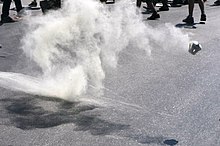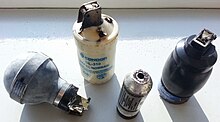Tear gas



Tear gas, formally known as a lachrymatory agent or lachrymator (from lacrima meaning "tear" in Latin), is a non-lethal chemical weapon that stimulates the corneal nerves in the eyes to cause tears, pain, and even blindness. Common lachrymators include pepper spray (OC gas), CS gas, CR gas, CN gas (phenacyl chloride), nonivamide, bromoacetone, xylyl bromide and syn-propanethial-S-oxide (from onions).
Lachrymatory agents are commonly used for riot control. Their use as chemical warfare agents is prohibited by various international treaties. During World War I, more toxic lachrymatory agents were used.
Effects
Tear gas works by irritating mucous membranes in the eyes, nose, mouth and lungs, and causes crying, sneezing, coughing, difficulty breathing, pain in the eyes, temporary blindness, etc. With CS gas, symptoms of irritation usually appear after 20–60 seconds of exposure and commonly resolve within 30 minutes of leaving (or being removed from) the area.[1] With pepper spray (OC gas), the onset of symptoms, including loss of motor control, is almost immediate, forcing the victim to abandon aggressive behavior in 90% of cases.[1]
Lachrymators are thought to act by attacking sulfhydryl functional groups in enzymes. One of the most probable protein targets is the TRPA1 ion channel that is expressed in sensory nerves (trigeminal nerve) of the eyes, nose and mouth.
Risks
As with all non-lethal, or less-than-lethal weapons, there is some risk of serious permanent injury or death when tear gas is used.[2][3] This includes risks from being hit by tear gas cartridges, which include severe bruising, loss of eyes, skull fracture, and even death.[4] While the medical consequences of the gases themselves are typically limited to minor skin inflammation, delayed complications are also possible: people with pre-existing respiratory conditions such as asthma, who are particularly at risk, may sometimes require hospitalization or even ventilation support.[5] Skin exposure to CS may cause chemical burns[6] or induce allergic contact dermatitis.[1] When people are hit at close range or are severely exposed, eye injuries involving scarring of the cornea can lead to a permanent loss in visual acuity.[7]
Use
Use in war
Use of tear gas in warfare (as all other chemical weapons) is prohibited by various international treaties[8] that most states have signed. Police and private self-defense use is not banned in the same manner. Armed forces can use tear gas for drills (practicing with gas masks) and for riot control. First used in 1914, xylyl bromide was a popular tearing agent since it was easily brewed.
The US Chemical Warfare Service developed tear gas grenades for use in riot control in 1919.[9]
Use in riot control

Certain lachrymatory agents are often used by police to force compliance, most notably tear gas.[3] In some countries (e.g., Finland, Australia, and the United States), another common substance is mace, which is the same as CN and is used as a self-defense weapon, in small spray cans. Xylyl bromide, CN and CS are the oldest of these agents, and CS is the most widely used.
Typical manufacturer warnings on tear gas cartridges state "Danger: Do not fire directly at person(s). Severe injury or death may result."[10] Such warnings are not necessarily respected, and in some countries, disrepecting these warnings is routine. In the 2013 protests in Turkey, there were hundreds of injuries among protestors targeted with tear gas projectiles.[11] This also happened during the 2013 protests in Brazil.
Counter-measures

The most obvious counter-measure is to prevent contact with the gas by leaving the area. Alternatively, a variety of protective equipment may be used, including gas masks and respirators. In riot control situations, protestors sometimes use a wide variety of equipment (aside from simple rags or clothing over the mouth) such as swimming goggles and adapted water bottles.[12]
Activists in the United States, the Czech Republic, and Turkey have reported using antacid solutions such as Maalox diluted with water as a remedy for tear gas attacks.[13][14][15] Milk and ayran are also used. Lemon juice is used.[16] Vinegar can burn the eyes and prolonged inhalation can also irritate the airways.[17]
Treatment

Once a person has been exposed, a variety of treatments may be used. The standard first aid for burning solutions in the eye is irrigation (spraying or flushing out) with water,[18] and some evidence suggests that diphoterine solution, a first aid product for chemical sprays, may help with ocular burns or chemicals in the eye.[18][19]
See also
References
- ^ a b c Smith, J (March 2002). "The use of chemical incapacitant sprays: a review" (PDF). J Trauma. 52 (3): 595–600. PMID 11901348. Retrieved 24 June 2013.
{{cite journal}}: Unknown parameter|coauthors=ignored (|author=suggested) (help) - ^ Heinrich U (September 2000). "Possible lethal effects of CS tear gas on Branch Davidians during the FBI raid on the Mount Carmel compound near Waco, Texas" (PDF). Prepared for The Office of Special Counsel John C. Danforth.
- ^ a b Hu H, Fine J, Epstein P, Kelsey K, Reynolds P, Walker B (1989). "Tear gas--harassing agent or toxic chemical weapon?" (PDF). JAMA. 262 (5): 660–3. doi:10.1001/jama.1989.03430050076030. PMID 2501523.
{{cite journal}}: Unknown parameter|month=ignored (help)CS1 maint: multiple names: authors list (link) - ^ Clarot F, Vaz E, Papin F, Clin B, Vicomte C, Proust B (2003). "Lethal head injury due to tear-gas cartridge gunshots". Forensic Sci. Int. 137 (1): 45–51. doi:10.1016/S0379-0738(03)00282-2. PMID 14550613.
{{cite journal}}: Unknown parameter|month=ignored (help)CS1 maint: multiple names: authors list (link) - ^ Carron, PN (19 June 2009). "Management of the effects of exposure to tear gas". BMJ. 338: b2283. doi:10.1136/bmj.b2283. PMID 19542106.
{{cite journal}}: Unknown parameter|coauthors=ignored (|author=suggested) (help) - ^ Worthington E, Nee PA (1999). "CS exposure—clinical effects and management". J Accid Emerg Med. 16 (3): 168–70. doi:10.1136/emj.16.3.168. PMC 1343325. PMID 10353039.
{{cite journal}}: Unknown parameter|month=ignored (help) - ^ Oksala A, Salminen L (1975). "Eye injuries cuased by tear-gas hand weapons". Acta Ophthalmol (Copenh). 53 (6): 908–13. doi:10.1111/j.1755-3768.1975.tb00410.x. PMID 1108587.
{{cite journal}}: Unknown parameter|month=ignored (help) - ^ e.g. the Geneva Protocol of 1925: 'Prohibited the use of "asphyxiating gas, or any other kind of gas, liquids, substances or similar materials"'
- ^ Jones DP (1978). "From Military to Civilian Technology: The Introduction of Tear Gas for Civil Riot Control". Technology and Culture. 19 (2): 151–168. JSTOR 3103718.
{{cite journal}}: Unknown parameter|month=ignored (help) - ^ Smith E (2011-01-28). "Controversial tear gas canisters made in the USA". Africa. CNN.com.
- ^ Turkish Doctors' Association, 16 June 2013, TÜRK TABİPLERİ BİRLİĞİ’NDEN ACİL ÇAĞRI !
- ^ "Gezi park protesters bring handmade masks to counter police tear-gas rampage". Hurriyet Daily News.
- ^ David Ferguson (2011-09-28). "'Maalox'-and-water solution used as anti-tear gas remedy by protesters". Raw Story.
- ^ "Medical information from Prague 2000".
- ^ Ece Temelkuran (2013-06-03). "Istanbul is burning". Occupy Wall Street.
- ^ Agence France-Press. "Tear gas and lemon juice in the battle for Taksim Square". NDTV. Retrieved 23 June 2013.
- ^ Toxic Use Reduction Institute. "Vinegar EHS". UMAss Lowell. Retrieved 22 June 2013.
- ^ a b Chau JP, Lee DT, Lo SH (2012). "A systematic review of methods of eye irrigation for adults and children with ocular chemical burns". Worldviews Evid Based Nurs. 9 (3): 129–38. doi:10.1111/j.1741-6787.2011.00220.x. PMID 21649853.
{{cite journal}}: Unknown parameter|month=ignored (help)CS1 maint: multiple names: authors list (link) - ^ Viala B, Blomet J, Mathieu L, Hall AH (2005). "Prevention of CS "tear gas" eye and skin effects and active decontamination with Diphoterine: preliminary studies in 5 French Gendarmes". J Emerg Med. 29 (1): 5–8. doi:10.1016/j.jemermed.2005.01.002. PMID 15961000.
{{cite journal}}: Unknown parameter|month=ignored (help)CS1 maint: multiple names: authors list (link)
Further reading
- BBC information about CS gas
- How to combat CS gas at eco-action.org
- Brone et al (2008)
